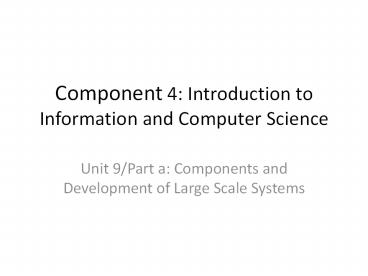Component 4: Introduction to Information and Computer Science - PowerPoint PPT Presentation
Title:
Component 4: Introduction to Information and Computer Science
Description:
Component 4: Introduction to Information and Computer Science Unit 9/Part a: Components and Development of Large Scale Systems – PowerPoint PPT presentation
Number of Views:393
Avg rating:3.0/5.0
Title: Component 4: Introduction to Information and Computer Science
1
Component 4 Introduction to Information and
Computer Science
- Unit 9/Part a Components and Development of
Large Scale Systems
2
Unit 9 Objectives
- Describe the building blocks of a large scale
system. - Explain the initial design process/options for a
large scale system. - Describe the evaluation process/criteria for
including and selecting existing software
applications. - Describe the process for new software
development. - Describe the different types of testing (unit,
system, usability) and when testing should occur. - Describe systems maintenance.
- Explain the process of financially supporting
large scale systems over time.
3
Topics in this Unit
- Topic I Building Blocks
- Topic II System Development Lifecycle
- Topic III Financial Support
4
Topic I Building Blocks
- Definitions
- Systems
- Computer Systems
- Information Systems
- Goals of the Information System
- Information System Technologies
- Stakeholder Roles
5
Systems
- A set of interacting and interdependent entities
forming an integrated whole - Examples
- Sociocultural systems
- Biological systems
- Computer systems
- Business systems
6
Computer Systems
- Computer systems include all elements needed for
the computer - Hardware
- Software
- Devices
- Large scale systems are computer systems capable
of processing large amounts of data
7
Information Systems
- An information system is a collection of people,
processes and technology - Working together to generate information needed
by users in an organization - Typically includes computers, but it doesnt have
to - Supports day-to-day information needs as well as
long-term planning - Used by employees and clients/customers
8
Goals of the Information System
- Improve business knowledge
- Improve business processes and services
- Improve business communications and people
collaboration
9
Information System Technologies
- Database technologies
- support business accumulation and use of business
knowledge. - Software technologies
- automate and support business processes and
services. - Interface technologies
- support business communications and collaboration.
10
Stakeholder Roles
- System owners
- Interested in information adding new business
knowledge - System users
- Capture, store, process, edit and use data
everyday - System designers
- Concerned with database technology
- System builders
- Represent data in very precise and unforgiving
languages
11
System Owners
- Usually from management
- Interested in the bottom line
- system cost
- value or benefits returned to the business
12
Goals of the System Owners
- Improve business knowledge
- Information scope and vision
- Improve business processes
- Functional scope and vision
- Improve business communications
- Communications scope and vision
13
System Users
- Majority of information workers in any
information system - Tend to be less concerned with costs and benefits
of the system - But they are concerned with system functionality
related to their jobs - Ease of learning
- Ease of use
- Get the job done
14
Goals of the System Users
- Improve business knowledge
- Business data requirements
- Improve business processes
- Business process requirements
- Improve business communications
- Business interface requirements
15
System Designers
- Database administrators
- Network architects
- Web architects
- Graphic artists
- Security experts
- Technology specialists
16
Goals of the System Designers
- Improve business knowledge
- Database design
- Improve business processes
- Business process design
- Software design
- Improve business communications
- Interface design
17
System Builders
- Applications programmers
- Systems programmers
- Database programmers
- Network administrators
- Security administrators
- Webmasters
- System integrators
18
Goals of the System Builders
- Improve business knowledge
- Database solutions
- Improve business processes
- Commercial software packages
- Custom-built application programs
- Improve business communications
- Interface solution
19
Systems Analysts
- A specialist who studies the problems and needs
of an organization to determine how people, data,
processes and information technology can best
accomplish improvements for the business. - Bridges the gap between perspectives of the
different stakeholders. - Overlaps the roles of other stakeholders.
20
External Service Providers
- Most External Service Providers (ESP) are systems
analysts, designers or builders contracted to
bring special expertise/experience to the
specific project. - Consultants are one example of an external
service provider or ESP.
21
Project Manager
- Project teams require management.
- One or more stakeholder takes on the role of
Project Manager (PM). - Ensures on-time development
- Keeps project within budget
- Maintains acceptable quality
22
(No Transcript)































